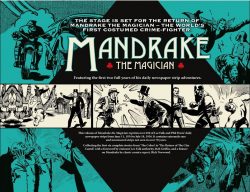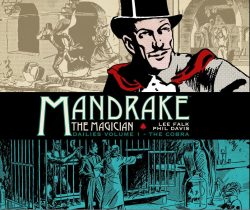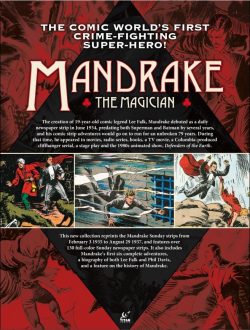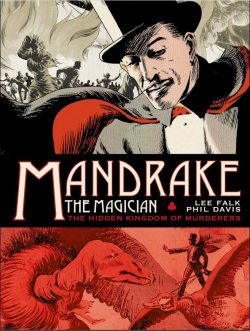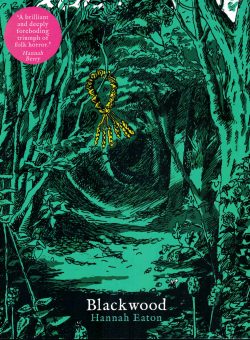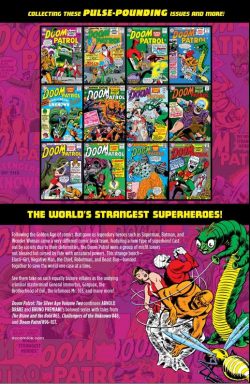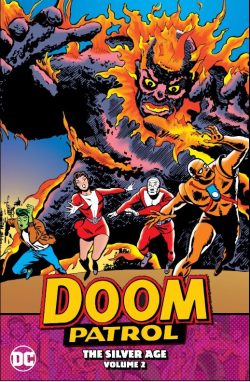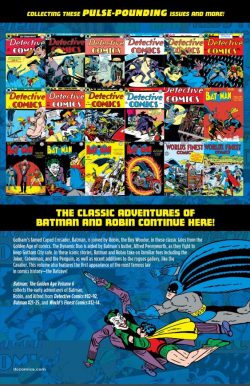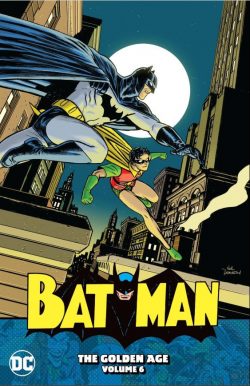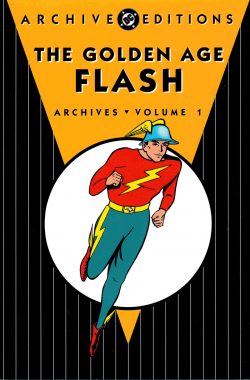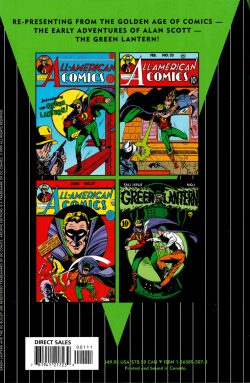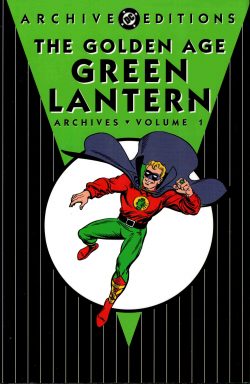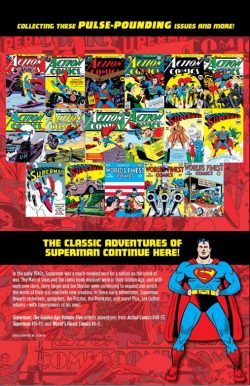
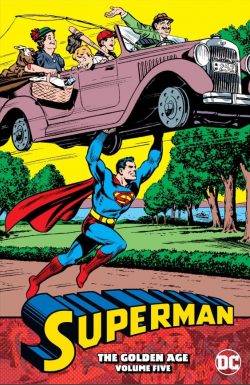
By Jerry Siegel & Joe Shuster, John Sikela, Leo Nowak, Ed Dobrotka, George Roussos, Sam Citron & various (DC Comics)
ISBN: 978-1-4012-8797-9 (TPB)
Win’s Christmas Gift Recommendation: Vital Vintage Superhero Fun and Fantasy… 9/10
The American comicbook industry – if it existed at all by now – would have been an utterly unrecognisable thing without The Man of Tomorrow. His unprecedented invention and adoption by a desperate and joy-starved generation gave birth to an entire genre if not an actual art form.
Imitation is the most honest compliment and can be profitable too. Superman triggered an inconceivable army of imitators and variations and, within three years of his Summer 1938 debut, the intoxicating blend of action and social wish-fulfilment which hallmarked the early Action Ace had grown to encompass cops-and-robbers crime-busting, socially reforming dramas, science fiction, fantasy, and whimsical comedy. Once the war in Europe and the East finally involved America, to that list was added patriotic relevance for a host of gods, heroes and monsters – all dedicated to profit through exuberant, eye-popping excess and vigorous dashing derring-do.
In comicbook terms at least, Superman was master of the world. He had already utterly changed the shape of the fledgling industry by the time of these tales. There was a successful newspaper strip, foreign and overseas syndication and the Fleischer studio was producing some of the most expensive – and best – animated cartoons ever conceived.
Thankfully the quality of the source material was increasing with every four-colour release, and the energy and enthusiasm of Jerry Siegel & Joe Shuster had infected the burgeoning studio that grew around them to cope with the relentless demand.
This latest addition to the splendid Golden Age/Silver Age strand of DC reprint compendia presents more of an epochal run of raw, unpolished but viscerally vibrant stories by Siegel, Shuster and the sterling crew of their “Superman Studioâ€. This stalwart band collaboratively set the nascent comics world on fire with crude, rough, uncontrollable wish-fulfilling, cathartically exuberant exploits of a righteous and superior man dealing out summary justice equally to social malcontents, exploitative capitalists, thugs and ne’er-do-wells, and captured the imagination of a generation.
This fifth remastered paperback collection (also available digitally) of the Action Ace’s early exploits – reprinted in the order they first appeared – covers the turbulent, times spanning May 1942 to February 1943: encompassing escapades from Action Comics #48-57, Superman #16-19 and his solo-adventures from World’s Finest Comics #6-8 (an oversized anthology title where he shared whimsical cover-stardom with Batman and Robin).
As always, every comic appearance is preceded by the original cover illustration depicting Superman trouncing scurrilous Axis War-mongers and reminding readers what we were all fighting for – captivating graphic masterpieces from Fred Ray, Jack Burnley and John Sikela – whilst each tale is credited to prolific co-originator Siegel.
I sometimes think – like many others I know – that superhero comics were never more apt or effective than when they were whole-heartedly combating global fascism with explosive, improbable excitement courtesy of a myriad of mysterious, masked marvel men.
All the most evocatively visceral moments of the genre seem to come when gaudy gladiators soundly thrashed – and I hope you’ll please forgive the offensive contemporary colloquialism – “Nips and Nazisâ€. However, even in those long-ago dark days, comics creators were wise enough to offset their tales of espionage and imminent invasion with a barrage of home-grown threats and gentler or even more whimsical four-colour fare…
Jerry Siegel was producing some of the best stories of his career, showing the Action Ace in all his morale-boosting glory; thrashing thugs, spies and masters of bad science whilst America kicked the Axis fascists in the pants…
Co-creator Joe Shuster, although plagued by punishing deadlines for the Superman newspaper strip and his rapidly failing eyesight, was still fully involved in the process, overseeing the stories and drawing character faces whenever possible, but as the months passed the talent pool of the “Superman Studio†increasingly took the lead in the comicbooks as the demands of the media superstar grew and grew. Thus, most of the stories in this volume were drawn by John Sikela with occasional support from others…
The magic begins with ‘The Merchant of Murder!’ from Action Comics #48 wherein the hero topples an insidious gang of killers led by The Top who uses wartime restrictions to sell used cars with deadly faults and defects until reporter Lois Lane and her soft-spoken leg man get involved…
Sikela flew solo on all of Superman #16, beginning with ‘The World’s Meanest Man’ as the Caped Kryptonian crushes a mobster attempting to plunder a social program giving deprived slum-kids a holiday in the countryside, before moving on to battle an astrologer prepared to murder his clients to prove his predictions in ‘Terror from the Stars’.
‘The Case of the Runaway Skyscrapers’ pits the Metropolis Marvel against Mister Sinister, a trans-dimensional tyrant who makes buildings vanish, after which the power-packed perilous periodical concluded with a deeply satisfying and classic campaign against organised crime as Superman crushes the ‘Racket on Delivery’.
Action Comics #49 introduced The Puzzler – a despicable, deadly and obsessive criminal maniac who hated losing and never played fair in ‘The Wizard of Chance’ (inked by Ed Dobrotka).
The debut of Superman propelled National Comics to the forefront of their fledgling industry and in 1939 the company collaborated with the organisers of the New York World’s Fair: producing two commemorative comic books celebrating the event. The Man of Tomorrow prominently featured on the appropriately titled New York World’s Fair Comics beside such four-colour stars as Zatara, Gingersnap, The Sandman and Batman and Robin. The spectacular card-cover 96-page anthologies were a huge hit and convinced National’s owner and editors that such an over-sized package of their pantheon of characters, with Superman and Batman prominently featured, would be a worthwhile proposition.
The bountiful format was retained for a wholly company-owned quarterly which retailed for the then-hefty price of 15¢. Launching as World’s Best Comics #1 (Spring 1941), the book transformed into World’s Finest Comics from #2, beginning a stellar 45-year run which only ended as part of the massive decluttering exercise that was Crisis on Infinite Earths.
From WFC #6 (Summer 1942), Siegel, Leo Nowak & Sikela’s ‘The Man of Steel vs. the Man of Metal’ pits our hero and newsboy Jimmy Olsen against Metalo: a mad scientist whose discoveries make him every inch Superman’s physical match…
Back in Action Comics #50, Clark Kent and Lois are despatched to Florida to scope out sporting skulduggery in ‘Play Ball!’– a light-hearted baseball tale illustrated by Nowak & Ed Dobrotka before Superman #17 offers a quartet of tales beginning with ‘Man or Superman?’ (pencilled by Shuster with Sikela inking), wherein Lois first begins putting together snippets of evidence and at last sensing that klutzy Clark might be hiding a Super-secret, even as the subject of her research tangles with sinister saboteur The Talon.
Following that, ‘The Human Bomb’ (art by Nowak) sees a criminal hypnotist transform innocent citizens into walking landmines until the tireless Action Ace scotches his wicked racket.
Sikela handled the last two tales in the issue beginning with ‘Muscles for Sale!’, in which Superman’s Fortress of Solitudeand Trophy Room debut and the Man of Steel battles another mad mesmerist turning ordinary citizens into dangerously overconfident louts, bullies and thieves, whilst ‘When Titans Clash!‘ depicts a frantic and spectacular duel of wits and incredible super-strength after Luthor regains the mystic Power Stone to become Superman’s physical – but never intellectual – master …
Action Comics #51 introduces the canny faux-madness of practical-joking homicidal bandit The Prankster in the rollercoaster romp in Sikela’s ‘The Case of the Crimeless Crimes’ and the next issue features the ‘The Emperor of America!’, wherein an invading army are welcomed with open arms by all Americans except the indignantly suspicious Man of Steel who single-handedly liberates the nation in a blistering, rousing call-to-arms classic…
As the war progressed the raw passion and sly wit of Siegel’s stories and the rip-roaring energy of Shuster and his team were galvanised by the parlous state of the planet and Superman got even became better and more flamboyant to deal with it all. His startling abilities and take-charge, can-do attitude won the hearts of the public at home and he was embraced as a patriotic tonic for the troops across the war-torn world.
The rise was meteoric, inexorable and unprecedented. He was the indisputable star of Action and World’s Finest Comics plus his own dedicated title, whilst a daily newspaper strip (begun on 16th January 1939, with a separate Sunday strip following from 5th November of that year) garnered millions of new fans globally. A thrice-weekly radio serial had been running since February 12th 1940 and, with a movie cartoon series, games, toys, apparel and a growing international media presence, Superman was swiftly becoming the entire Earth’s hero…
Although the gaudy burlesque of evil aliens, marauding monsters and slick super-villains still lay years ahead of our hero, thrilling tales of villainy, criminality, corruption and disaster were just as engrossing and spoke powerfully of the tenor of the times, and are all dealt with in a direct and captivating manner by our relentlessly entertaining champion in summarily swift and decisive fashion.
No “To Be Continueds†here!
A perfect example of the done-in-one tale is Siegel, Nowak & Sikela’s ‘The Eight Doomed Men’ from World’s Finest Comics #7: a tale involving a coterie of ruthless millionaires targeted for murder because of the wicked past deeds of their privileged college fraternity. This enthralling crime mystery is suitably spiced up with flamboyant high-tech weaponry that pushes the Man of Tomorrow to his limits…
Superman #18 (September/October 1942) then offers a quartet of stunning sagas, leading with Sikela’s ‘The Conquest of a City’ wherein Nazi infiltrators use a civil defence drill to infiltrate the National Guard and conquer Metropolis in the Fuehrer’s name… until Superman spearheads the counter-attack…
Nowak’s ‘The Heat Horror’ posits an artificial asteroid threatening to burn the city to ashes until the Metropolis Marvel defeats Lex Luthor, the manic mastermind who initially aimed it at Earth.
‘The Man with the Cane’ offers a grand, old-fashioned and highly entertaining espionage murder mystery for Dobrotka & Sikela to illustrate after which Superman takes on his first fully costumed super-villain when ‘The Snake’ perpetrates a string of murders during construction of a river tunnel in a moody Nowak-drawn masterpiece.
Sikela is inked by George Roussos on fantastic thriller ‘The Man Who put Out the Sun!’ from Action Comics #53, wherein bird-themed bandit Night-Owl uses “black light†technology and ruthless gangsters to plunder at will until the Man of Steel takes charge, whilst in #54, ‘The Pirate of Pleasure Island!’ (Sikela) follows the foredoomed career of upstanding citizen Stanley Finchcomb, a seemingly civilised descendent of ruthless buccaneers who succumbs to madness and becomes a modern day merciless marine marauder. Or perhaps he truly is possessed by the merciless spirit of his ancestor Captain Ironfist in this enchanting supernatural thriller…?
A classic (and much reprinted) fantasy shocker opened Superman #19. ‘The Case of the Funny Papers Crimes’ (Sikela & Dobrotka) sees bizarre desperado Funnyface bring the larger-than-life villains of the Daily Planet’s comics page to terrifying life in a grab for loot and power, after which ‘Superman’s Amazing Adventure’ (Nowak) finds the Man of Steel battling incredible creatures in an incredible extra-dimensional realm – but all is not as it seems…
Some of the city’s most vicious criminals are commanded to kill a stray dog by the infamous Mr. Z in ‘The Canine and the Crooks’ (Nowak) and it takes all of Clark and Lois’ deductive skills to ascertain why before ‘Superman, Matinee Idol’breaks the fourth wall for readers as the reporters visit a movie house to see a Superman cartoon in a shameless yet exceedingly inventive and thrilling “infomercial†plug for the Fleischer Brothers cartoons then currently astounding movie-goers; all lovingly rendered by Shuster and inked by Sikela…
This latest leaf through times gone by continues with a witty and whimsical Li’l Abner spoof illustrated by Sikela & Dobrotka. ‘A Goof named Tiny Rufe’ focuses on desperate cartoonist Slapstick Sam who co-opts, plagiarises and ruins the simple lives of a couple of naïve hillbillies to fill his idea-empty panels and pages… until Superman intercedes to give the hicks their lives back and the devious dauber the drubbing he so richly deserves……
World’s Finest #8 (Winter, 1942-1943) next exposed ‘Talent Unlimited’ (Sam Criton & Sikela) as Superman tracks down a missing heiress who had abandoned wealth for a stage career and poor but honest theatrical friends. Unfortunately, even though she didn’t want her money, other people did…
A brace of episodes from Action Comics brings this gleaming Golden Age visit to a close, starting with ‘Design for Doom!’ from #56. Illustrated by Sikela, it pits the Caped Kryptonian against a deranged architect who creates global city-wrecking catastrophes simply to prove the superiority of his own creations.
Superman was pitifully short on returning villains in the early days so #57’s return of the Prankster as ‘Crime’s Comedy King’ made a welcome addition to his meagre Rogues Gallery, especially as the Macabre Madcap seems here to have turned over a new philanthropic leaf. Of course, there’s malevolence and a big con job at the heart of his transformation…
As fresh, thrilling and compelling now as they ever were, these endlessly re-readable epics are perfectly presented in these glorious paperback collections where the graphic magic defined what being a Super Hero means, with every tale dictating the basic iconography of the genre for all others to follow.
These Golden Age tales are priceless enjoyment at absurdly affordable prices and in a durable, comfortingly approachable format. What dedicated comics fan could possibly resist them?
© 1942, 1943, 2020 DC Comics. All Rights Reserved.
